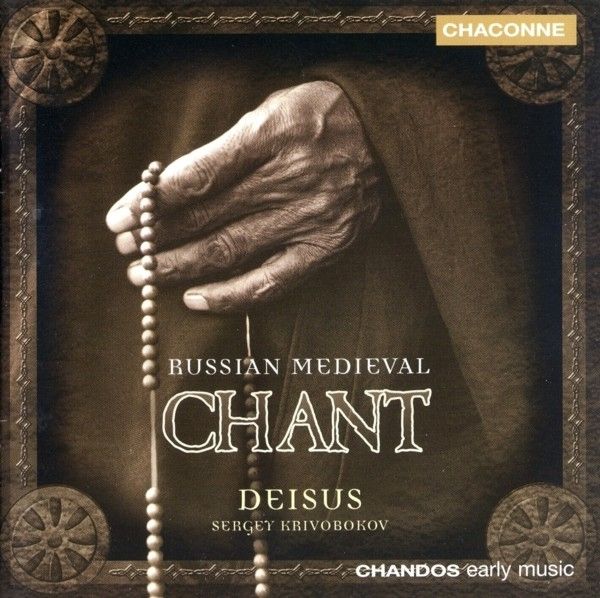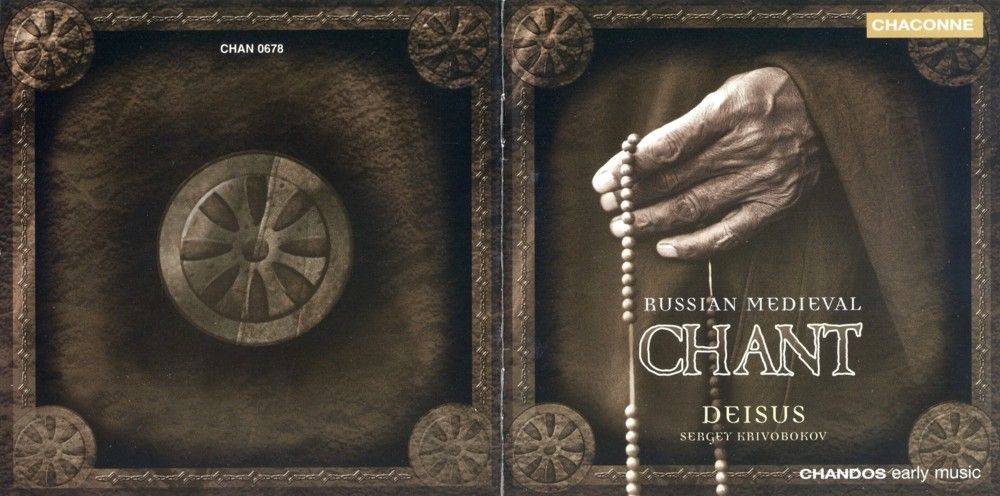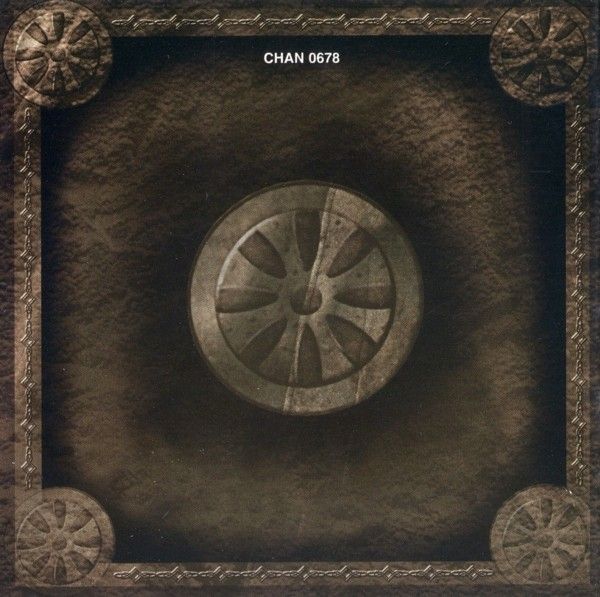Russian Medieval Chant
Deisus

amazon.com
Chandos Chaconne CHAN 0678
2001
1. Иоаким и Анна [2:24]
Joachim and Anna
2. Яже прежде неплодная страна [2:18]
As a previsouly barren land
3. Чужде матерем девство [3:18]
Maidenhood alien to mothers
4. В благознаменитый день [8:17]
On this important day
5. Возсия день радостен [5:52]
Radiant is this joyful day
6. Днесь собори верных [7:59]
This day the congregations of the faithful
7. Ангели вхождение Пречистыя зряще [4:00]
The Angels, seeing the entrance of the most pure Maiden
8. Днесь во храм приводиться [3:24]
This day to the church comes the most immaculate Maiden
9. Да веселятся небеса [7:01]
Let the heavens be joyful
10. Яко одушевленному Божию киоту [3:38]
Like the icon given life by God
11. Архангельский глас [1:07]
We exclaim to you with the voice of the Archangel
12. Еже от века таинство [5:40]
So that the mystery might be revealed
13. Егда изыде Богородице Дево [9:50]
When, O Virgin Maid
14. На безсмертное Твое успение [5:02]
On your immortal assumption
Deisus
Sergey Krivobokov
Recording producer: Yevgeny Safronov
Sound engineer: Aleksandr Kalashnikov
Music consultant: Galina PozhidayevaLtd
© 2001 Chandos Records Ltd

Chants in honour of
the Virgin
These amazing chants caress the human soul, exposing it to goodness,
light and beauty, assuaging suffering and implanting in it the great
meaning of Life.
The tradition of monophonic church singing came to Russia from
Byzantium as the most important aspect of the divine service.
For the faith of the Christ-loving Prince Yaroslav, three Greek singers
and their families came, inspired by the Lord, from Constantinople.
With them the art of angelic singing began in Russia...
The history of the origins of Russian church singing has come down to
us thanks to the chronicler of the Book of Degrees (1). And it
seems sometimes that in these ancient chants we can hear the voices of
those nameless ‘Greek singers’, and through them the vast
Byzantine world and the world of Christendom to which Russia has always
been tied by invisible bonds. And through this sense of common humanity
the simple monophonic chants are filled with even greater meaning for
us.
In the course of their thousand-year history the canonical texts were
treated in different ways: in the early period as monophonic, and later
as polyphonic, chants. The structure of the Orthodox divine service,
its sublimity, the leisurely pace of the ritual, the narrative tone of
the liturgical readings, which had to create a specific impact on the
worshippers, undoubtedly influenced the character of the chants that
formed part of the church ceremony. The poetic text always played the
leading role in this, whilst the melody merely assisted in adding
expression to the delivery. The relationship of the melody to the text
was governed by understanding the subordinate role of the melody and
the functional significance of the music as a whole. All this taken
together determined the art of the chant writers, who were able to
interpret the poetry of the liturgical texts in different singing
traditions.
The oldest chant of the Russian Orthodox Church is the znamennïy
chant. Its name derives from the Slavonic word ‘znamya’ (a
sign) and it is associated with a particular type of neumatic notation
used at this time. The speech patterns of the chanted church readings,
with their rising and falling, wavelike contours and characteristic rallentando
at the ends of the lines, form the basis of znamennïy
chant.
Festive znamennïy chants were characterised by greater
solemnity, achieved through a wide range of melodic embellishments, the
so-called stroki mudrïya, litsa and fitï.
The last of these derived from the Greek letter θ, which gave its
name to this kind of singing.
The development of church singing led to new types of znamennïy
chant: the bol'shoy, malïy, putevoy and demestvennïy
forms. The bol'shoy (grand) chant was a new, elaborate version
of the znamennïy chant which appeared before the end of
the fifteenth century. One of the creators of this style was the
greatest chant writer of the second half of the sixteenth century,
Fyodor Krestyanin.
The malïy (small) chant appeared as a counterbalance to
the bol'shoy, being an abbreviated version of the znamennïy
chant. Already known in the second half of the sixteenth century, it
gained greater currency from the beginning of the seventeenth when it
was used for setting verses from the Gospels and selected verses for
the principal church festivals, including the feast of the Presentation
of the Blessed Virgin and the Annunciation. By its name this version
denotes a chant with a smaller (by comparison with the normal,
prevalent version) melismatic range, thereby making it similar to
liturgical recitative.
The works of Russian chant writers have remained basically anonymous to
this day; only certain names have come down to us through the ages.
Among them is Faddey Nikitich Subotin who lived in the mid-seventeenth
century and was a master of the Usolsk School and deacon of the
Annunciation Cathedral in Solvïchеgodsk. As an expert in Usolsk
‘mastersinging’, Faddey Subotin presented it before the
committee headed by Aleksandr Mezenets which was responsible in 1669
for correcting the chant books.
The znamennïy verses for the Birth of the Virgin in the
‘arrangement’ by Faddey Subotin are written in the finest
traditions of znamennïy chant; they differ from the chants
of the Moscow School in a certain archaicism and in the use of novel
melodic formulae.
From the end of the fifteenth century putevoy (or putnïy)
chant became established in the rules for church singing alongside the znamennïy
chant. This style took its name from the word ‘put'’ (way)
and by the close of the next century the practice was so widespread
that it was second only to znamennïy chant.
The history of putevoy chant was closely bound up with the
monastic cult. The largest monasteries in central and northern Russia
had their putevoy ‘arrangements’: trinity put'
at the Trinity Sergius Monastery; solovetsky put' at the
Solovetsky Monastery; and the kirillov bol'shoy put' at the
Kirillo-Belozersky Monastery. The austere and ascetic character of the putevoy
chants can be heard in the slow rhythmic unfolding and the smooth
melodic contours of their melodies.
Demestvennïy chant, the earliest examples of which can be
dated to the last quarter of the fifteenth century, became the most
solemn type of singing in Muscovite Russia, and the people of that era
held it to be the most perfect and skilful. The festive and uplifting
qualities, which manifested themselves in extensive melismatic singing,
characteristic sound patterns and rhythms, grandiose designs and
novelty in the compositions, have placed demestvennïy
chant at the forefront of the musical art of those times.
Evidence has survived to show that Ivan the Terrible knew demestvennïy
chant:‘with fair singing the tsar himself with his flock sang at
matins and in the liturgy’. Demestvennïy chant was
also heard in staged performances — in the unique mystery play of
the Middle Ages The Fiery Furnace — and was featured in
the tributes addressed to the tsar and patriarch, and the most
important verses for feast days in the tsar's presence.
Subsequently the scope of church singing widened with the inclusion of
later chants, i.e. Bulgarian, Greek and Kievan. In the second half of
the seventeenth century there was a shift to the new style of partesnïy
singing which grew from the polyphonic arrangements of znamennïy
chants. The tenor sang the monophonic znamenniy chant, and the
remaining voices provided the harmonised chordal accompaniment.
Characteristic of Russian choral singing is the extraordinarily
well-developed bass part, introducing elements of a concerto style and
demanding on the part of the performers an advanced, sometimes
virtuosic, technique. This anticipates the transparency of the rhythmic
movement in partesnïy compositions.
With their austere, prayer-like quality the old chants which were
created by the nameless pupils and disciples of the three Greek singers
‘to praise and glorify the Lord’ will always unite us by
their closeness to goodness, light and beauty.
© Galina Pozhidayeva
Translation: Philip Taylor
1. Book of Degrees, a chronicle written in 1560-63 by Ivan the
Terrible's confessor, Andrey (later Metropolitan Afanasy)
The Deisus choir came into being in 1977 when Sergeу Krivobokov, who
has acquired wide experience in Old Russian church singing during his
long professional career, and Yevgeny Sаfгonov decided to combine their
knowledge and enthusiasm to make a contribution towards the revival of
the Old Russian tradition of church singing. It consists of fourteen
professional singers whose primary objective is to familiarise
listeners and specialists with the unknown pages of traditional church
vocal art. The choir consults world-renowned Russian musicologists and
medievalists, including the outstanding specialist Galina Zandreyevna
Pozhidayeva. Many of the chants performed are unique, and in some cases
there are no known attempts to decipher the ancient neumes other than
those especially made by musicologists in order to broaden the
repertoire of the Deisus choir.



